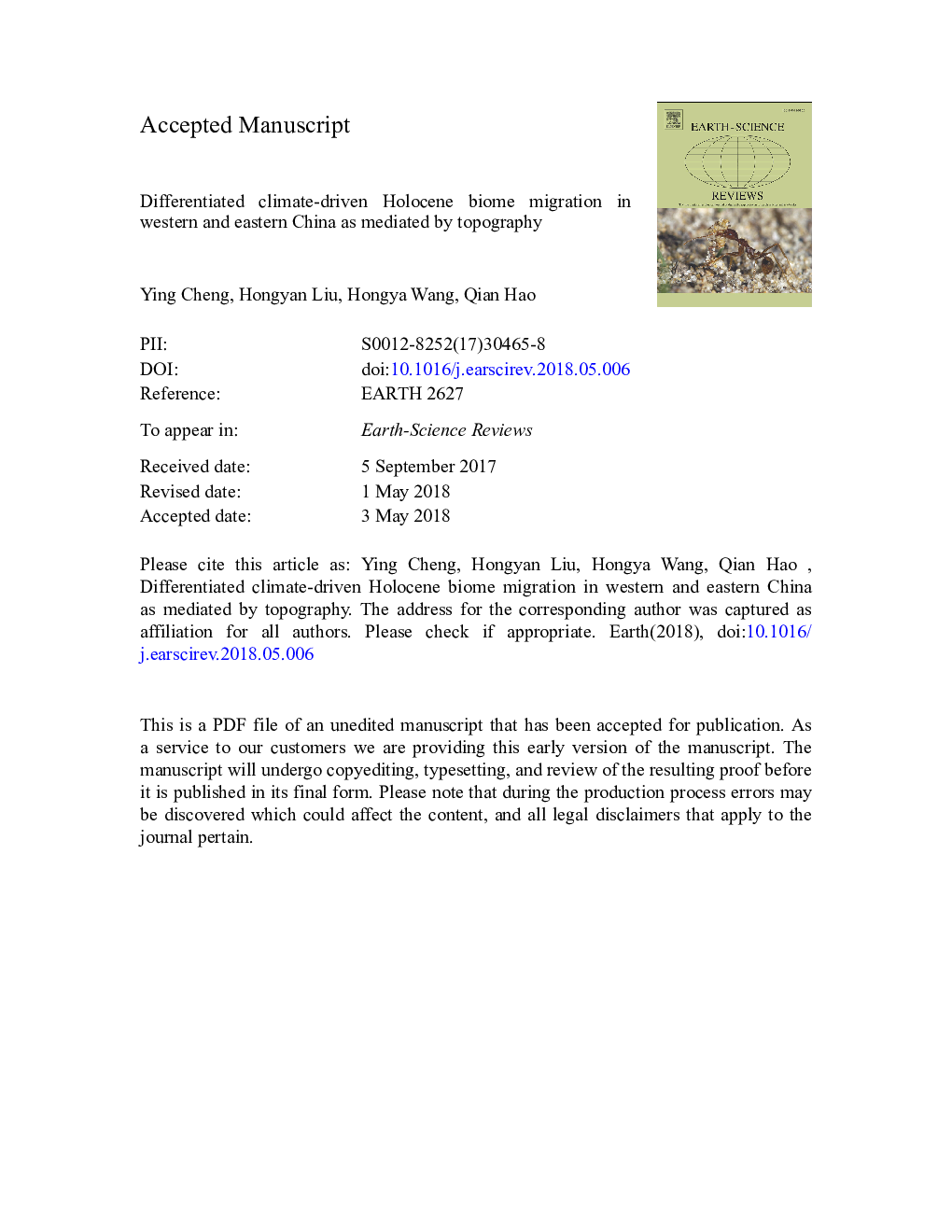| کد مقاله | کد نشریه | سال انتشار | مقاله انگلیسی | نسخه تمام متن |
|---|---|---|---|---|
| 8912927 | 1639920 | 2018 | 39 صفحه PDF | دانلود رایگان |
عنوان انگلیسی مقاله ISI
Differentiated climate-driven Holocene biome migration in western and eastern China as mediated by topography
ترجمه فارسی عنوان
مهاجرت بیوم های هولوسن به اقلیم متمایز شده در غرب و شرق چین به دلیل میانجیگری توپوگرافی
دانلود مقاله + سفارش ترجمه
دانلود مقاله ISI انگلیسی
رایگان برای ایرانیان
کلمات کلیدی
مهاجرت بیوم، موزون تابستان آستارا، توپوگرافی، هولوسن،
ترجمه چکیده
در سرزمین اصلی چین از غرب به شرق اختلاف زیادی وجود دارد. با این حال، تاثیر نسبی توپوگرافی و سیستم های خاص آب و هوایی، مانند موزون شرق آسیا، بر مهاجرت بیوم گذشته، به خوبی درک نشده است، که برای پیش بینی آینده دگرگونی بیوم مشکل است. به طور کامل از دانش ما، این مطالعه برای اولین بار به طور جامع تعیین می کند که آیا توپوگرافی مؤثر بر مهاجرت بیوم های هولسن تحت تاثیر آب و هوا در چین است. ما 69 توالی گرده را در سرزمین اصلی چین تدوین کردیم تا بتوانیم مهاجرت بیولوژی هولوسن را با استفاده از رویکرد بیومیزیک استاندارد انتساب بیوم به گرده از طریق نوع عملکردی گیاه بازسازی کنیم. نتایج ما نشان می دهد که غرب چین با زنجیره کوه های شرق و غرب، یک الگو مهاجرت جنگل متفاوتی را تجربه کرده است، در حالی که چین شرقی و شرقی بدون زنجیره کوه شرق و غرب، پاسخ مشابهی با الگوی مهاجرت رسمی جنگل از نظر افقی و کمربند عمودی. موانع جغرافیایی ممکن است بعنوان پناهگاه در غرب چین عمل کنند و بقای جنگل را تسهیل کنند و در سطح بیوم گسترش پیدا کنند، که با سرعت مهاجرت جنگل سریعتر از آنچه در میان شرق و شرق چین تجربه می شود، مشخص می شود. این نوع مهاجرت بیوم در مقیاس قاره نیز می تواند تقسیم بندی را در تغییرات دامنه گونه ای متعادل کند. هنگامی که کل چین وسط خاور میانه را پیدا کردیم، متوجه شدیم که موشسهای تابستان شرقی شرقی آب، به طور قابل توجهی بر مرز شمالی جنگل در کمربند افقی و مرز بالایی جنگل در کمربند عمودی تأثیر می گذارد. تعاملات میان میانه های عرضی و نیمه عرضی در فصل تابستان، نقش مهمی در تعیین موقعیت مرز شمالی جنگل در ناحیه حاشیه ای دریایی آثار دریایی داشتند که منجر به یک مرز ناپایدار در مقیاس سالانه با تغییرات نوسان شد. این مطالعه بر اهمیت میانجیگری توپوگرافی در هنگام بررسی مهاجرت بیوم های هولوسن به آب و هوا در غرب و شرق چین تأکید می کند.
موضوعات مرتبط
مهندسی و علوم پایه
علوم زمین و سیارات
زمین شناسی
چکیده انگلیسی
There are large differences in terrain from west to east in mainland China. However, the relative influence of topography and specific climate systems, such as the East Asian monsoon, on past biome migration is poorly understood, which is problematic for the prediction of future biome dynamics. To the best of our knowledge, this study is the first to comprehensively determine whether topography has mediated climate-driven Holocene biome migration in China. We compiled 69 pollen sequences in mainland China to reconstruct Holocene biome migration using a standard biomization approach of biome assignment according to pollen by plant functional type. Our results show that western China, with its east-west mountain chains, experienced a differentiated forest migration pattern, while middle and eastern China, with no east-west mountain chains, had similar responses, with a directional forest migration pattern in terms of horizontal and vertical belts. Geographical barriers might have acted as refugia in western China and facilitated forest survival and spread at the biome level, characterized by a faster forest migration rate than that experienced in middle and eastern China. This type of continental-scale biome migration could also balance fragmentation in species range-shifts. When taking middle and eastern China as a whole, we found that the water-bearing East Asian summer monsoon significantly influenced the forest northern boundary in the horizontal belt and the forest upper boundary in the vertical belt. Interactions between the mid-latitude westerlies and the low-latitude summer monsoon had a complex role in determining the position of the forest northern boundary in the East Asian monsoon-margin region, resulting in a millennial-scale unstable boundary with fluctuating variations. This study highlights the importance of topography mediation when investigating climate-driven Holocene biome migration in western and eastern China.
ناشر
Database: Elsevier - ScienceDirect (ساینس دایرکت)
Journal: Earth-Science Reviews - Volume 182, July 2018, Pages 174-185
Journal: Earth-Science Reviews - Volume 182, July 2018, Pages 174-185
نویسندگان
Ying Cheng, Hongyan Liu, Hongya Wang, Qian Hao,
